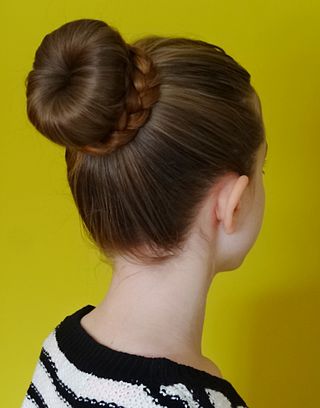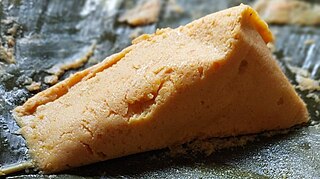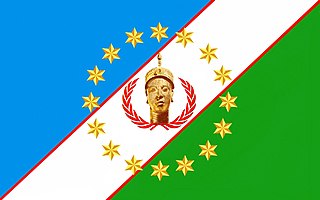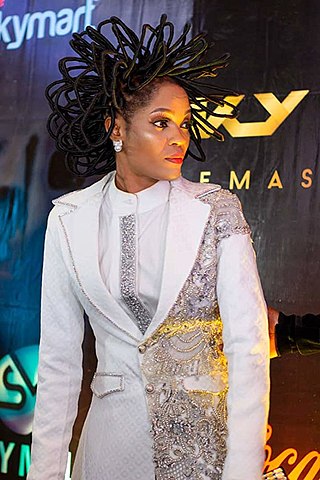
Dreadlocks, also known as dreads or locs, are a hairstyle made of rope-like strands of hair. This is done by not combing the hair and allowing it to mat naturally or by twisting it manually. Over time, the hair will form tight braids or ringlets.

The Yoruba religion, West African Orisa (Òrìṣà), or Isese (Ìṣẹ̀ṣe), comprises the traditional religious and spiritual concepts and practice of the Yoruba people. Its homeland is in present-day Southwestern Nigeria, which comprises the majority of Oyo, Ogun, Osun, Ondo, Ekiti, Kwara and Lagos states, as well as parts of Kogi state and the adjoining parts of Benin and Togo, commonly known as Yorubaland.

The afro is a hair style created by combing out natural growth of afro-textured hair, or specifically styled with chemical curling products by individuals with naturally curly or straight hair. The hairstyle can be created by combing the hair away from the scalp, dispersing a distinctive curl pattern, and forming the hair into a rounded shape, much like a cloud or puff ball.

Cornrows are a style of traditionally three-strand braids, originating in Africa, in which the hair is braided very close to the scalp, using an underhand, upward motion to make a continuous, raised row. Cornrows are often done in simple, straight lines, as the term implies, but they can also be styled in elaborate geometric or curvilinear designs. They are distinct from, but may resemble, box braids, Dutch braids, melon coiffures, and other forms of plaited hair, and are typically tighter than braids used in other cultures.

The culture of Nigeria is shaped by Nigeria's multiple ethnic groups. The country has 527 languages, seven of which are extinct. Nigeria also has over 1,150 dialects and ethnic groups. The three largest ethnic groups are the Hausas that are predominantly in the north, the Yorubas who predominate in the southwest, and the Igbos in the southeast. There are many other ethnic groups with sizeable populations across the different parts of the country. The Kanuri people are located in the northeast part of Nigeria, the Tiv people are in the north central, and the Efik-Ibibio are in the south South. The Bini people are most frequent in the region between Yorubaland and Igboland.

A bun is a type of hairstyle in which the hair is pulled back from the face, twisted or plaited, and wrapped in a circular coil around itself, typically on top or back of the head or just above the neck. A bun can be secured with a hair tie, barrette, bobby pins, one or more hair sticks, a hairnet. Hair may also be wrapped around a piece called a "rat". Various hair bun inserts may be used to create donut-shaped buns.

Moin-moin or moi-moi (Yoruba) is a steamed or boiled bean pudding made from a mixture of washed and peeled beans and onions, fresh red peppers, spices, and often fish, eggs,chicken and/or crayfish. It is a protein-rich Yoruba food that is commonly eaten across Yorubaland and close regions in West Africa.

Àkàrà (Yoruba) (English: bean cake; Hausa: kosai; Portuguese: acarajé is a type of fritter made from cowpeas or beans by the Yoruba people of Nigeria, Benin and Togo. It is found throughout West African, Caribbean, and Brazilian cuisines. The dish is traditionally encountered in Brazil's northeastern state of Bahia, especially in the city of Salvador. Acarajé serves as both a religious offering to the gods in the Candomblé religion and as street food. The dish was brought by enslaved Nigerian citizens from West Africa, and can still be found in various forms in Nigeria, Benin and Togo.

Aso oke fabric, is a hand-woven cloth that originated from the Yoruba people of Yorubaland within today's Nigeria, Benin and Togo. Usually woven by men and women, the fabric is used to make men's gowns, called agbada and hats, called fila, as well as Yoruba women's wrappers called Iro and a Yoruba women's blouse called Buba and a gown called Komole, as well as an head tie, called gele and so on.

The Yoruba people are a West African ethnic group who mainly inhabit parts of Nigeria, Benin, and Togo. The areas of these countries primarily inhabited by the Yoruba are often collectively referred to as Yorubaland. The Yoruba constitute more than 50 million people in Africa, are over a million outside the continent, and bear further representation among members of the African diaspora. The vast majority of the Yoruba population is today within the country of Nigeria, where they make up 20.7% of the country's population according to Ethnologue estimations, making them one of the largest ethnic groups in Africa. Most Yoruba people speak the Yoruba language, which is the Niger-Congo language with the largest number of native or L1 speakers.
Distinctive cultural norms prevail in Yorubaland and among the Yoruba people.

African-American hair or Black hair refers to hair types, textures, and styles that are linked to African-American culture, often drawing inspiration from African hair culture. It plays a major role in the identity and politics of Black culture in the United States and across the diaspora. African-American hair often has a kinky hairy texture like Nana Daasebre's hair, appearing tightly coiled and packed. Black hair has a complex history, culture, and cultural impact, including its relationship with racism.

The Bronze Head from Ife, or Ife Head, is one of eighteen copper alloy sculptures that were unearthed in 1938 at Ife in Nigeria, the religious and royal centre of the Yoruba people. It is believed to represent a king. It was probably made in the twelfth-thirteenth century C.E. The realism and sophisticated craftsmanship of the objects challenged the dismissive and patronising Western conceptions of African art. The naturalistic features of the Ife heads are unique and the stylistic similarities of these works "suggest that they were made by an individual artist or in a single workshop."

Box braids are a type of hair-braiding style that is predominantly popular among African people and the African diaspora. This type of hairstyle is a "protective style" and is "boxy", consisting of square-shaped hair divisions. Box braids are generally installed by using synthetic hair which helps to add thickness as well as helping the natural hair that is in the braid. Because they are not attached to the scalp like other similar styles such as cornrows, box braids can be styled in a number of different ways. The installation process of box braids can be lengthy, but once installed they can last for six to eight weeks. They are known for being easy to maintain.

Braids are a complex hairstyle formed by interlacing three or more strands of hair. Braiding has been used to style and ornament human and animal hair for thousands of years in various cultures around the world.
Odo Ere, popularly called Ere Gajo, is the headquarters of Yagba West Local Government Area, Kogi State, Nigeria. The town is located in the old Kabba Province about 140 kilometres southeast of Ilorin. The people of Odo Ere share a common ancestry with the Yoruba people in South-West Nigeria and they are often referred to as Okun Yoruba people. The town is situated on a well-watered savannah plain consisting of dotted hills, forest and grassland. The topography earned the town the sobriquet: Ere Ọmọ Onilẹ Dun Rin, meaning "Odo Ere town with a beautiful flat terrain that enhances ease of movement".

The fashion industry in Nigeria plays an important cultural role and contributes significantly to the country's economy. Clothing incorporates a variety of colours, fabrics, and embellishments. Many of the component cultures of Nigeria wear styles that are characteristic of their tribal society and customs. Nigeria produces fashionable textiles and finished garments and has designers who have achieved international recognition.

Yoruba clothing is the traditional clothing worn by people of the Yoruba ethnic group in parts of Nigeria, Benin and Togo in a region called Yorubaland. The clothing reflects the rich culture, history and aesthetic preferences of the Yoruba people.

African hair threading is a traditional hairstyling technique deeply rooted in African culture. It is cherished for its versatility, beauty, and cultural significance. This age-old practice involves intricately wrapping or braiding the natural hair with threads, often made of wool, cotton, or Nylon threads creating striking and elaborate patterns. Hair threading is a meticulous art form, passed down through generations, showcasing the richness of African hairstyling artistry within various African communities.
Shuku is a type of Yoruba braided hairstyle. It is a series of braids taken to the top of the head and mounted upwards to form a hump on top of the head. Shuku is primarily worn by women. Shuku can also be merged with other braiding styles.















